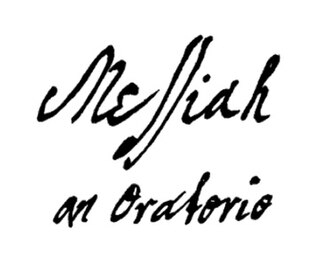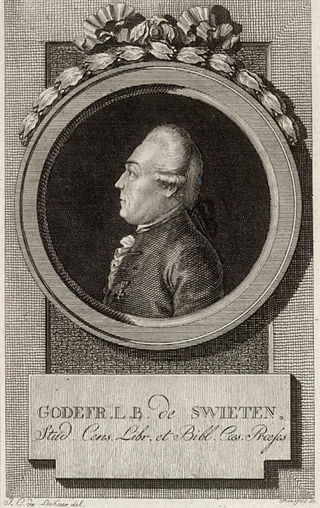
Messiah is an English-language oratorio composed in 1741 by George Frideric Handel. The text was compiled from the King James Bible and the Coverdale Psalter by Charles Jennens. It was first performed in Dublin on 13 April 1742 and received its London premiere nearly a year later. After an initially modest public reception, the oratorio gained in popularity, eventually becoming one of the best-known and most frequently performed choral works in Western music.

Elijah, Op. 70, MWV A 25, is an oratorio by Felix Mendelssohn depicting events in the life of the Prophet Elijah as told in the books 1 Kings and 2 Kings of the Old Testament. It premiered on 26 August 1846.

Judas Maccabaeus is an oratorio in three acts composed in 1746 by George Frideric Handel based on a libretto written by Thomas Morell. The oratorio was devised as a compliment to the victorious Prince William Augustus, Duke of Cumberland upon his return from the Battle of Culloden. Other catalogues of Handel's music have referred to the work as HG xxii; and HHA 1/24.

Esther is an oratorio by George Frideric Handel. It is generally acknowledged to be the first English oratorio. Handel set a libretto after the Old Testament drama by Jean Racine. The work was originally composed in 1718, but was heavily revised into a full oratorio in 1732.
La resurrezione, HWV 47, is an oratorio by George Frideric Handel, set to a libretto by Carlo Sigismondo Capece (1652–1728). Capece was court poet to Queen Marie Casimire of Poland, who was living in exile in Rome. It was first performed on Easter Sunday, 8 April 1708 at Rome, with the backing of the Marchese Francesco Ruspoli, Handel's patron at this time. The work details the events between — and during — Good Friday and Easter Sunday, with the action carried forward in recitative, and exploration of character and delineation of mood taking place in the arias. The characters of the liturgical drama that appear in the oratorio are Lucifer (bass), Mary Magdalene (soprano), an angel (soprano), John the Evangelist (tenor), and Mary Cleophas (alto).

John Christopher Smith was an English composer who, following in his father's footsteps, became George Frideric Handel's secretary and amanuensis.

Joshua is an oratorio by George Frideric Handel. It was composed in a month, from 19 July 1747 to 19 August 1747, six months before the beginning of the oratorio season. Joshua is Handel's fourth oratorio based on a libretto by Thomas Morell. The oratorio premiered on 9 March 1748 at the Covent Garden Theatre, London. Joshua is based on the Biblical story of Joshua as the leader of the ancient Israelites. The story follows the Israelites from their passage over the Jordan River into Caanan and through the Battle of Jericho. The work also includes a love story elaborated from a few hints in the Biblical narrative between Caleb's daughter Achsah and Othniel, a young soldier.

An Occasional Oratorio is an oratorio by George Frideric Handel, based upon a libretto by Newburgh Hamilton after the poetry of John Milton and Edmund Spenser. The work was written in the midst of the Jacobite rising of 1745–1746, the attempt to overthrow Handel's patrons the Hanoverian monarchy under George II and replace them with a Stuart restoration under Charles Edward Stuart, "Bonnie Prince Charlie". The Occasional Oratorio is unique among Handel's works which he labelled "oratorio" in that it does not tell a story or contain elements of a drama, but was intended as a defiant and patriotic rallying piece.

The Brockes Passion, or Der für die Sünde der Welt gemarterte und sterbende Jesus, is a German oratorio, libretto by Barthold Heinrich Brockes, first published in 1712 and seeing 30 or so more editions over the following 15 years.

Gideon is an oratorio pastiche compiled largely from the works of George Frideric Handel by John Christopher Smith. It was first performed on 10 February 1769 at Covent Garden, London.

Hannah is an oratorio in three acts by Christopher Smart with a score composed by John Worgan. It was first performed in Haymarket theater 3 April 1764. It was supposed to have a second performance, but that performance was postponed and eventually cancelled over a lack of singers. A libretto was published for its run and a libretto with full score was published later that year.

Giulia Frasi was born c. 1730 and died in 1772 or after May 1774. She was an Italian soprano who was primarily active in London. She sang in every one of Handel's English oratorios, including various world premières for which the composer wrote roles specifically for her.

The Oratorio de Noël, Op. 12, by Camille Saint-Saëns, also known as his Christmas Oratorio, is a cantata-like work scored for soloists, chorus, organ, strings and harp. While an organist at La Madeleine, Saint-Saëns wrote the Christmas oratorio in less than a fortnight, completing it ten days before its premiere on Christmas 1858. The vocal score of this oratorio was prepared later by the composer and organist Eugene Gigout, a colleague of Saint-Saëns.

Messiah, the English-language oratorio composed by George Frideric Handel in 1741, is structured in three parts. The wordbook was supplied by Charles Jennens. This article covers Part I and describes the relation of the musical setting to the text. Part I begins with the prophecy of the Messiah and his virgin birth by several prophets, namely Isaiah. His birth is still rendered in words by Isaiah, followed by the annunciation to the shepherds as the only scene from a Gospel in the oratorio, and reflections on the Messiah's deeds. Part II covers the Passion, death, resurrection, ascension, and the later spreading of the Gospel. Part III concentrates on Paul's teaching of the resurrection of the dead and Christ's glorification in heaven.

Messiah, the English-language oratorio composed by George Frideric Handel in 1741, is structured in three parts. This listing covers Part II in a table and comments on individual movements, reflecting the relation of the musical setting to the text. Part I begins with the prophecy of the Messiah and his birth, shows the annunciation to the shepherds and reflects the Messiah's deeds on earth. Part II covers the Passion in nine movements including the oratorio's longest movement, an air for alto He was despised, then mentions death, resurrection, ascension, and reflects the spreading of the Gospel and its rejection. The part is concluded by a scene called "God's Triumph" that culminates in the Hallelujah chorus. Part III of the oratorio concentrates on Paul's teaching of the resurrection of the dead and Christ's glorification in heaven.

Messiah, the English-language oratorio composed by George Frideric Handel in 1741, is structured in three parts. This listing covers Part III in a table and comments on individual movements, reflecting the relation of the musical setting to the text. Part I begins with the prophecy of the Messiah and his birth, shows the annunciation to the shepherds as a scene from the Gospel of Luke, and reflects the Messiah's deeds on Earth. Part II covers the Passion, death, resurrection, ascension, and the later spreading of the Gospel. Part III concentrates on Paul's teaching of the resurrection of the dead and Christ's glorification in heaven.
Carolyn Sampson is an English soprano in opera and concert. Specialising in historically informed performance, she has sung in Masaaki Suzuki's recording project of Bach cantatas and has appeared at the English National Opera.

Parnasso in festa, per li sponsali di Teti e Peleo, by George Frideric Handel, is a festa teatrale, a form also called a "serenata", a type of Italian opera intended as entertainment to celebrate a festive royal or state occasion. The work was written to celebrate the marriage of Anne, Princess Royal and Prince William of Orange. Parnasso in festa had its first performance in London at the King's Theatre on 13 March 1734 and was repeated five times. The operatic entertainment, to an anonymous libretto, was such a success at its London premiere that although it was intended as a one-off production for a royal wedding, Parnasso in festa was revived by Handel in several subsequent seasons.

Der Messias, K. 572, is Wolfgang Amadeus Mozart's 1789 German-language version of Messiah, George Frideric Handel's 1741 oratorio. On the initiative of Gottfried van Swieten, Mozart adapted Handel's work for performances in Vienna.

"Tochter Zion, freue dich" is a Christian Advent song in German. The text was written by Friedrich Heinrich Ranke, based on music derived from two of Handel's oratorios. The song was published in 1826, assigned to the Entry into Jerusalem. The hymn is part of the German Protestant hymnal Evangelisches Gesangbuch as EG 13 and the 2013 Catholic hymnal Gotteslob as GL 228, both four-part settings in the Advent section.












